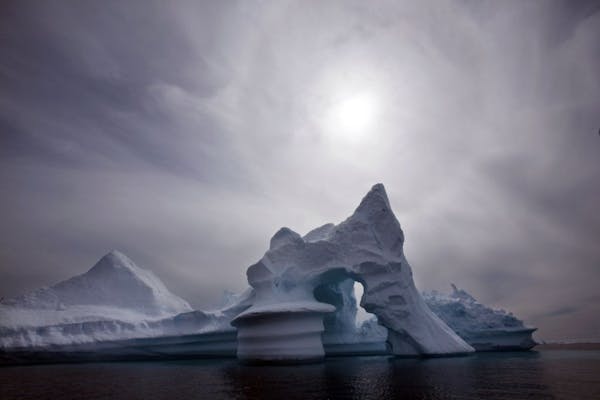Blizzard Nemo follows Hurricane Sandy. Drought spreads from the plains to the American Southwest. Last year was the warmest U.S. year on record.
Our media reminds us that extreme weather is a consequence of global warming, and that we can expect more of it as the atmosphere warms.
But as to storms, we should note that the past seven-year period, overall, has been one the quietest for hurricanes in the last century. And we should remember the Long Island Express of 1938, which killed 600, and the Midwest's Great Blizzard of 1978. Category 5 hurricanes Andrew (1992) and Camille (1969), along with others, were much stronger than Sandy. All this was before atmospheric carbon dioxide (CO2) reached current levels.
Researchers from the U.S. Forest Service, using tree-ring data, have identified six multiyear droughts between 1750 and 1950. All were much more severe than anything in recent memory, because they persisted for years.
We now have data on world 2012 temperatures from NOAA and the other international agencies that monitor global temperatures. Our recently warm Lower 48 is less than 2 percent of the Earth's surface. Despite our high temperatures, the average global surface temperature for January to December 2012 was 0.57 degrees C (1.03 degrees F) above the 20th-century average, but essentially unchanged from average global temperatures in the 2003 to 2012 period. Atmospheric CO2 levels continue to rise, but global temperatures are taking a 10-year breather for reasons that are not well-understood.
Perhaps we are entering a period of global luke-warming, in which adaptation will be as effective as the costly mitigation programs that are currently in vogue.
Carbon dioxide is a nontoxic gas that resonates with the Earth's outgoing infrared, making it a greenhouse gas. There are now about 3 trillion tons of it in the Earth's atmosphere. CO2 makes plants grow, dough rise and beverages fizz, and we exhale it.
There is still only one CO2 molecule for every 2,400 molecules in the atmosphere. But when the widely scattered CO2 molecules sense the earth's infrared, they go into motion, bumping neighboring nitrogen and oxygen molecules, sending them into motion. The whole atmosphere is jiggled and gets warmer because a product of motion is heat. When you are cold, you instinctively shiver to get warmer. The other greenhouse gases, such as water vapor and methane, also promote the motion. The science is clear, and it suggests that we should be warming as fast as some of the models predict.
Mitigation programs are focused on reducing the burning of carbon-based fossil fuels by substituting renewables like wind, solar and biofuels. Intermittent and costly wind and solar are not effective as large-scale additions to carefully balanced electric grids. Germany is the poster country for solar energy, with a half-million rooftop and other solar-panel systems. These require $10 billion in annual subsidies. The German Physical Society writes: "Photovoltaics are fundamentally incapable of replacing any other type of power plant."
Essentially, every solar array must be backed up with a conventional power plant as a reserve, creating an expensive double infrastructure. The same is true for variable output wind turbines.
We currently use 40 percent of our corn and 40 million prime crop acres to produce ethanol, which meets about 6 percent of our gasoline consumption. The result is increased world grain prices and stresses to soils, ground water and the environment from monoculture corn and additional nitrogen fertilizers. A University of Minnesota study also showed that on average in the United States, 142 gallons of water are needed to grow and process the corn for one gallon of ethanol.
Congress passed the 2007 Energy Independence and Security Act, calling for the production of 100 million gallons of nonfood cellulosic biofuel in 2010, rising to 1 billion gallons in 2013. But there is no effective production process for cellulosic or algae biofuel, and the most we have produced in any year is about 5 million gallons at very high cost.
Undaunted, the Obama administration has awarded $510 million for the construction of cellulosic and algae biofuel production plants for military jet fuel. Using an as yet mythical production process, these new plants are to supply biofuels to the Navy for a plan known as the Great Green Fleet. The motive is to lessen dependence on countries "that don't share the same values as the United States."
But there is an entirely new reality in U.S. energy production and consumption. New oil and gas supply is emerging, and fossil-fuel demand is being reduced by conservation and costs. Oil imports are declining to the point that all our needs may soon be coming from friendly Western Hemisphere sources. U.S. refineries can supply all Defense Department fuel needs from domestic crude oil.
It's time to join the pause in global luke-warming and also pause in the building of multibillion-dollar projects like Cape Wind and Ivanpah Solar that produce modest amounts of usable energy.
There is time to spend some of the money on research into what is really happening with our climate.
--------
Rolf Westgard is a professional member of the Geological Society of America and teaches energy classes in the University of Minnesota's Lifelong Learning program.

Should Metro Mobility even be thought of as supplemental?

What does Anoka-Hennepin really teach about DEI?


